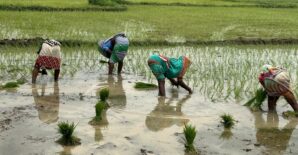
Dhanusha District, Nepal.
Credit: Divya Pandey, IFPRI
Food safety is interlinked with food and nutritional security. Growing urbanization, increase in income, change in taste preference and consumer preference have led to increase in demand for safe food.
A recent IFPRI discussion paper on Adoption of Food Safety Measures among Nepalese Milk Producers investigates the status, cost, and assesses the impact of compliance with food safety measures in milk production in the country.
The authors collected data at the farm level from six districts of Nepal, known for their geographical and institutional diversity of milk production. Caste, number of children and elders in a family, herd size, access to information, household labour size, perception of households about food safety, assistance provided by milk buyers, and market outlet types were few of the factors associated with the adoption of food safety measures. According to the study, the adoption intensity of food safety practices shows inter and intra district variations.
In 2013, the National Dairy Development Board (NDDB) indicated that the dairy farmers’ inability to adhere to the food safety measures at farm level is responsible for the first important entry points of bacterial contamination in the milk chain of the country. As compared to the international standard, Nepal’s mean total bacterial count (TBC) was nine times higher on farm and 104 times higher in plant, warranting the urgent need of improving quality of milk production.
In the process of enhancing the milk production through commercial farming, it becomes more significant to address the issue of clean and hygienic milk production and distribution. Dairy farms can become a harbour of food borne pathogens. Thus, arising the possibility of contaminated milk at the farm itself, which becomes unsafe for consumption despite the proper discretion and treatment along the value chain. Issues such as animal welfare, prevalence of drug residues and antibiotics resistance can be addressed at the farm level. If not dealt with at the farm level, the consumption of contaminated milk can expose the consumers to pathogenic bacteria.
Food safety has emerged as the most valued attribute by both consumers and producers from developed and developing countries. The research findings include that the profitability of farm decreases at the higher level of the adoption of food safety measures, thus, reducing incentives to be involved in the hygienic milk production activities. This gives rise to the need for establishing pricing scheme based on the quality of milk production. While farms producing high quality milk deserve extra bonus, the ones producing low quality milk should be strictly penalized. The government needs to focus on providing subsidies in selling utensils necessary for hygienic milk production and also run a result-efficient training and awareness program.



